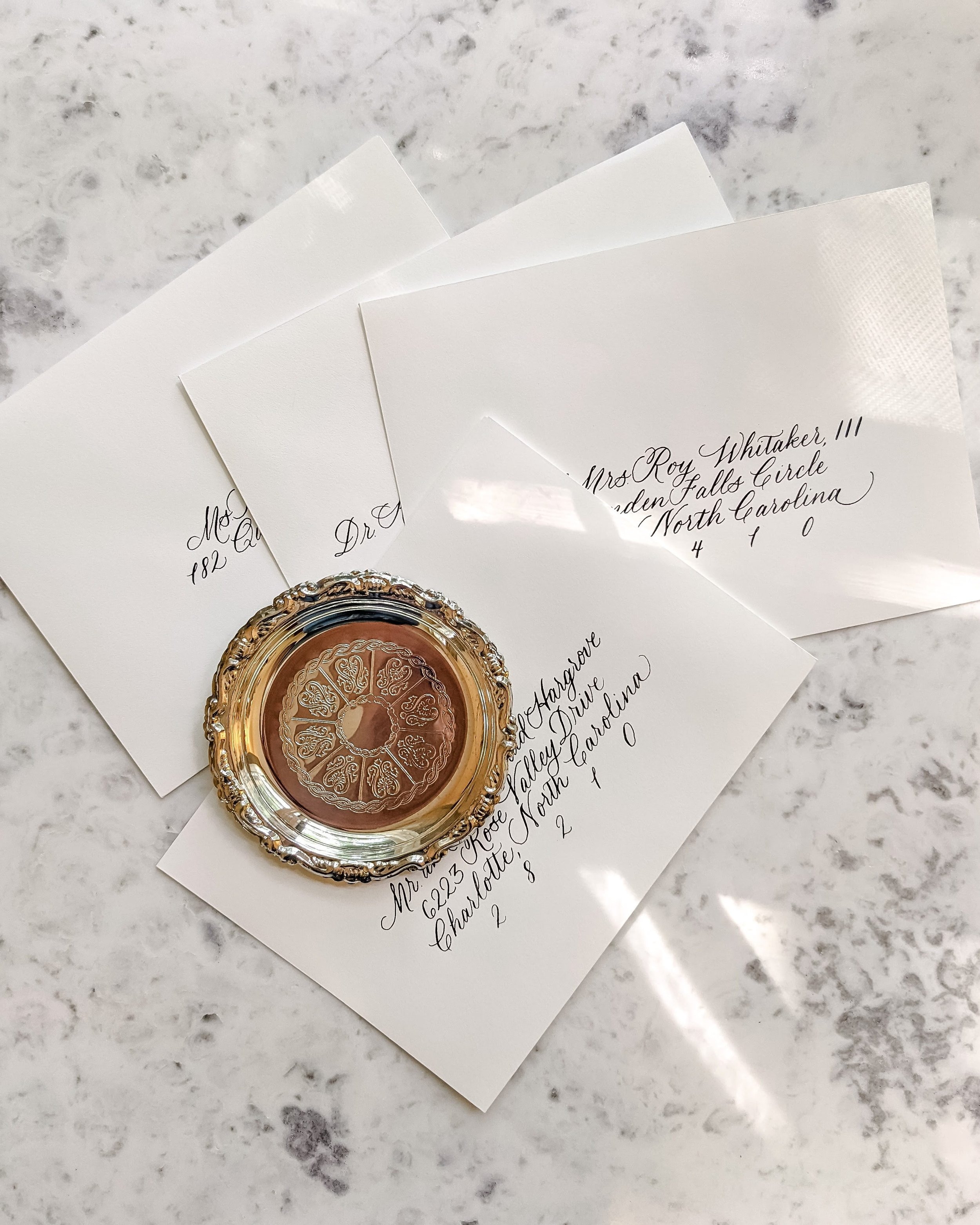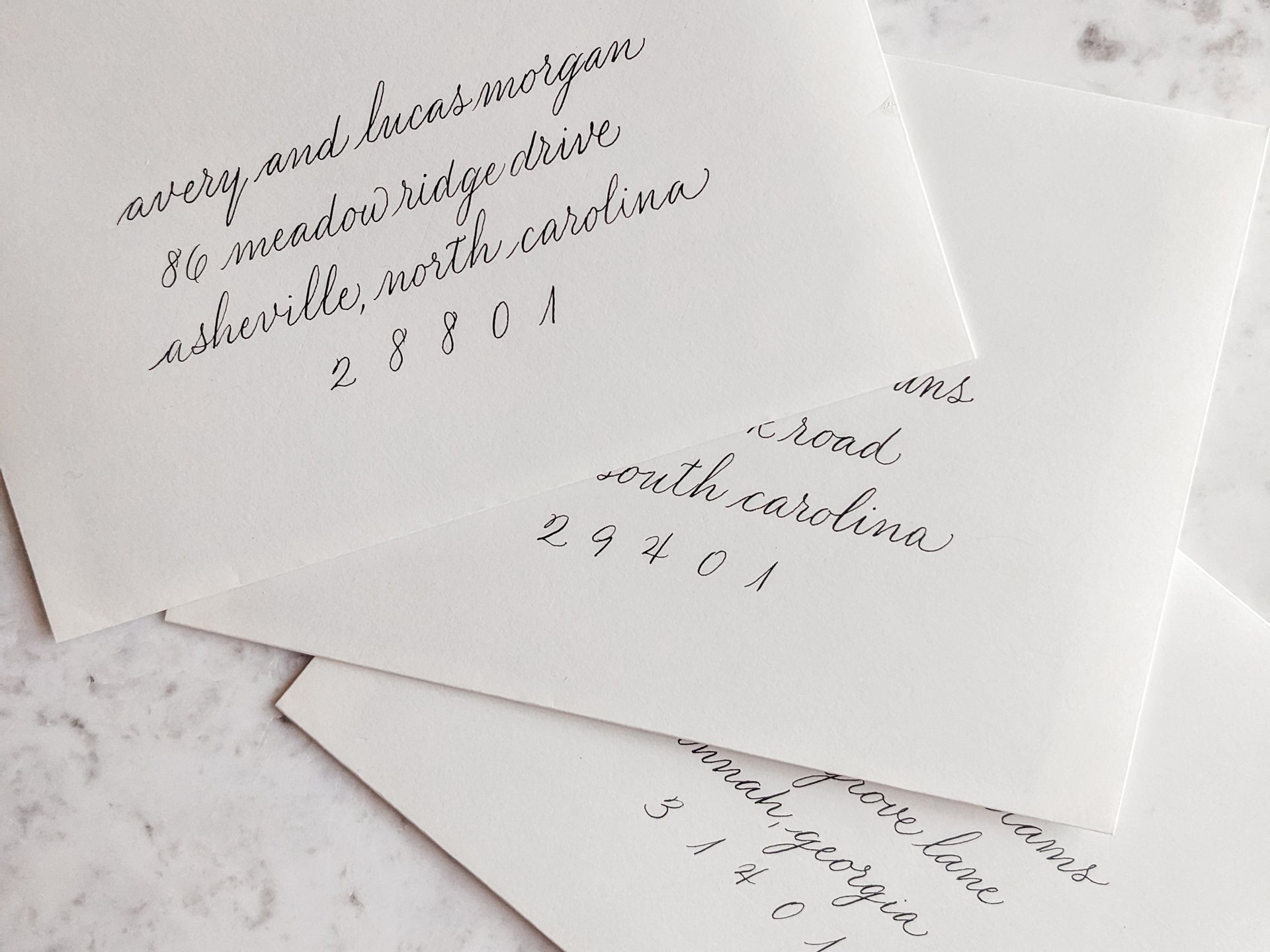Wedding Calligraphy Etiquette Tips: A Quick Guide from a Calligrapher
When it comes to wedding stationery, etiquette is more than just following tradition—it’s about creating a thoughtful and unforgettable guest experience. From addressing envelopes to crafting day-of details, calligraphy etiquette sets the tone for your celebration and ensures your guests feel truly valued. As your calligrapher, I’ll make navigating these traditions easy (and dare I say, fun!) so you can focus on what matters most—enjoying your big day! 🥂
If you’re curious about all the ins and outs of envelope addressing etiquette, I’ve created a detailed cheat sheet that I share exclusively with my clients. But for now, here’s a peek at some key highlights to get you started:
A Brief History of Formal Etiquette
Etiquette in calligraphy and stationery has been around for centuries, rooted in traditions that predate the Victorian era and have evolved over centuries to the modern celebrations we know today. At its core, formal addressing is about showing respect and care for your guests. Whether your wedding is a formal black-tie affair, a sophisticated cocktail soirée, or even an intimate garden celebration at a historic estate, these traditions help ensure your stationery feels intentional and reflects the importance of your day.
Titles and rankings—like "Dr.," "Reverend," or military designations—are a form of address that conveys esteem, courtesy, and respect. Including these in formal invitations highlights the importance of your event and demonstrates your care for honoring your guests. These small but significant touches let your guests know how much you value their presence.
Common Wedding Calligraphy Etiquette Questions
1. How Do I Address Married Couples? Traditional etiquette calls for formal titles, like “Mr. and Mrs. John Smith.” For a modern and inclusive approach, I recommend skipping titles altogether and using "Jane and John Smith," which feels fresh, approachable, and perfectly aligned with today’s weddings.
2. What About LGBTQ+ Couples? Inclusivity is everything! For married couples, list their names alphabetically or in the order they prefer. For example: “Alex Taylor and Chris Jones.” Titles depend on personal preferences—some guests may love traditional ones like "Dr.," "Mr.," or "Ms.," while others might choose "Mx." or none at all. When in doubt, just ask! It’s a simple step that shows you care about getting it right.
3. Inner vs. Outer Envelopes: Do I Need Both? Inner envelopes have a fascinating history—they were originally used to protect invitations from dirt and damage. Today, they’re more about adding that extra layer of charm and sophistication.
They’re also perfect for showcasing thoughtful embellishments, like wax seals or custom liners—details that make your stationery feel uniquely you. Beyond aesthetics, they clarify exactly who’s invited. For example:
Outer envelope: “Mr. and Mrs. John Smith”
Inner envelope: “Mr. and Mrs. Smith” and, if applicable, the children’s names listed in age order (e.g., “Anna, Ben, and Charlotte”).
This extra touch ensures clear communication, whether you’re inviting the whole family or keeping it adults-only.
Etiquette for Day-Of Details
Etiquette doesn’t end with invitations! Day-of details like escort cards, place cards, and signage are essential for helping your guests feel welcomed and appreciated. These thoughtful touches not only provide clear guidance for seating but also ensure a cohesive and polished experience that reflects the tone of your celebration. Learn more about my day-of calligraphy services here.
Escort Cards vs. Place Cards: Escort cards guide guests to their table, while place cards direct them to a specific seat. Both should reflect the formality and style of your event—whether that’s formal titles ("Dr. Emma Brown") or something more relaxed ("Emma").
Seating charts offer another way to display seating arrangements and can be customized to suit your wedding’s tone. You might choose to list each individual guest (e.g., "Jane Smith") for a clear and inclusive approach, or opt to group by couple or family (e.g., "Mr. and Mrs. Robert Smith") for a more traditional route. Whatever you decide, consistency is key to keeping the presentation clear and ensuring your guests feel welcomed and confident in finding their place.
Breaking the Rules (Intentionally!)
Etiquette is a guide, not a rulebook. Your wedding should reflect you and your partner. For example:
Prefer a full lowercase address for a chic, modern vibe? Do it!
Want to use nicknames on place cards? It’s your day—make it fun!
My job is to help you strike the perfect balance between tradition and creativity so your details feel intentional and uniquely yours.
Why Work with a Calligrapher?
Let’s face it—wedding etiquette can feel overwhelming. That’s where I come in. When you work with me, you’ll get:
Personalized guidance on all things etiquette. ✍️
A seamless process that makes your vision a reality. 💌
Access to my exclusive envelope addressing etiquette cheat sheet—so you never have to Google questions like "how to address a married couple with different last names" or "what do I write for nonbinary guests." If your guest list includes unique situations, I’m just a message away to help with personalized guidance specific to your wedding. Explore my envelope calligraphy services here.
Let’s Create Something Beautiful
From envelopes to day-of details, I’m here to ensure your wedding calligraphy is polished, cohesive, and uniquely yours. Have questions about etiquette? I’m always here to guide you every step of the way. Contact me here to get started! 🥂
Ready to get started? Let’s chat about how we can bring your vision to life! 🥂





